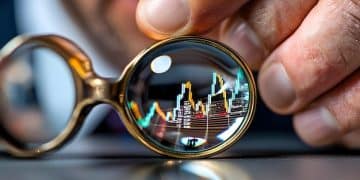Inflation’s True Cost: Your Savings in 2025 Guide

Understanding the complex dynamics of inflation is crucial for safeguarding your financial future, as its persistent erosion of purchasing power significantly impacts the real value of your savings, requiring proactive strategies in 2025.
In an economic landscape constantly shifting, deciphering the true value of your hard-earned money can feel like navigating a dense fog. This guide on Understanding the Impact of Inflation on Your Savings: A 2025 Guide aims to cut through that fog, providing clarity on how rising prices directly affect your financial nest egg and what proactive steps you can take to mitigate its eroding effects as we approach 2025.
The Persistent Tug-of-War: Inflation’s Core Dynamics
Inflation, at its heart, is a measure of the rate of increase in the average price level of a basket of goods and services over time. While often discussed in abstract terms, its concrete manifestation is the decreasing purchasing power of your money. What USD 100 bought you last year might only buy USD 95 worth of goods today, effectively shrinking your savings without any transactions taking place.
Understanding the interplay of supply and demand, fiscal policy, and global events is critical to grasping inflation’s pervasive influence. As economic conditions evolve, so too does the pressure on prices, making it a continuous challenge for savers. In 2025, several factors are poised to continue shaping this dynamic, from geopolitical tensions impacting supply chains to domestic fiscal policies.
Demand-Pull vs. Cost-Push Inflation
Economists typically categorize inflation into two primary types, each with distinct causes and implications:
- Demand-Pull Inflation: This occurs when aggregate demand in an economy outpaces aggregate supply. Too much money chasing too few goods leads to higher prices. This can be fueled by robust consumer spending, government stimulus, or rapid money supply growth.
- Cost-Push Inflation: This type arises from increases in the cost of production, such as higher wages, raw material prices, or energy costs. Businesses pass these elevated costs onto consumers through higher prices, even if demand remains stable.
Both types can co-exist and often feed into each other, creating a complex inflationary environment. For your savings, the source of inflation matters less than its existence, as both diminish your money’s future buying power.
The Federal Reserve and other central banks employ various tools to manage inflation, primarily by adjusting interest rates. Higher interest rates are intended to cool down an overheating economy by making borrowing more expensive, thereby reducing demand. However, these policies also impact the returns on savings accounts and other low-risk investments, sometimes creating a difficult balancing act for individual savers trying to maintain real value.
Being aware of these underlying mechanisms allows for a more informed approach to managing your financial assets. It moves beyond simply observing rising prices to comprehending why they are rising and what that means for your long-term financial health.
Quantifying the Erosion: How Inflation Shrinks Your Wealth
The impact of inflation on your savings often feels subtle initially, like a slow leak rather than a sudden burst. However, over time, this insidious erosion can significantly diminish the real value of your wealth. While your bank balance may appear static or even grow modestly with interest, it’s the ‘real’ return after accounting for inflation that truly matters.
Consider a simple example: if you have USD 10,000 in a savings account earning a 1% annual interest rate, and inflation runs at 3%, your real return is -2%. This means your money can buy 2% less than it could the previous year, despite earning some interest. This concept, known as purchasing power, is fundamental to understanding inflation’s direct threat to your financial security.
The Real Return Equation
The formula for calculating your real return is straightforward:
Nominal Return – Inflation Rate = Real Return
Where Nominal Return is the interest rate or investment gain you receive before accounting for inflation. If your nominal return is less than the inflation rate, your purchasing power is declining. This negative real return is precisely why a passive savings approach in an inflationary environment is often detrimental to long-term wealth accumulation.

The challenge for savers is that many traditional savings vehicles, such as basic savings accounts and some certificates of deposit (CDs), often offer nominal interest rates that barely keep pace with, or sometimes fall short of, inflation. This necessitates a more active and strategic approach to managing your money, especially as we look towards 2025, where various uncertainties persist.
Understanding how different assets perform in an inflationary environment is also crucial. While cash and low-yield savings accounts are most vulnerable, other assets like real estate, inflation-protected securities (TIPS), and certain commodities tend to fare better. However, each comes with its own set of risks and considerations that require careful evaluation.
The key takeaway is that merely holding onto money or keeping it in accounts with negligible interest rates guarantees a loss of purchasing power over time. Proactive planning and a willingness to explore various financial instruments are essential to protect your savings from inflation’s silent, but powerful, grasp.
Traditional Savings Vehicles: Are They Enough in 2025?
For many years, traditional savings accounts and Certificates of Deposit (CDs) have been considered the bedrock of personal finance, offering security and predictable, albeit modest, returns. However, in an inflationary environment, their effectiveness in preserving wealth is significantly diminished. As we look towards 2025, a critical assessment of these vehicles is necessary.
Savings accounts, while offering liquidity and safety through FDIC insurance in the US, typically provide interest rates that are far below the prevailing inflation rate. This means that the real value of the money held in these accounts is steadily decreasing over time. While convenient for emergency funds, they are not ideal for long-term wealth accumulation when inflation is high.
Evaluating CDs and Money Market Accounts
Certificates of Deposit (CDs) offer slightly higher interest rates than standard savings accounts, in exchange for locking up your funds for a specific period. The longer the term, generally the higher the interest rate. However, even these rates often struggle to outpace inflation, especially during periods of elevated price increases.
- CDs:
- Pros: Predictable returns, low risk, FDIC insured.
- Cons: Limited liquidity, interest rates often below inflation, early withdrawal penalties.
- Money Market Accounts (MMAs):
- Pros: Better interest rates than savings accounts, check-writing privileges, FDIC insured.
- Cons: Less liquid than checking, rates can fluctuate, often still lag behind significant inflation.
For 2025, the landscape for these traditional options will likely remain challenging if inflationary pressures persist. While they remain essential for short-term financial needs and emergency funds, relying on them exclusively for long-term savings strategies is a recipe for losing purchasing power. Savers need to consider a more diversified approach that includes assets offering better inflation protection.
The goal should shift from merely accumulating nominal dollars to preserving and growing your real purchasing power. This often involves taking on a degree of calculated risk beyond what traditional savings vehicles offer. It’s about finding the right balance between safety, liquidity, and growth potential to ensure your money works as hard as you do.
Therefore, while traditional savings vehicles play a vital role in a comprehensive financial plan, they should not be the sole component, especially when inflation is a significant concern. A thoughtful portfolio, incorporating various asset classes, is increasingly important for safeguarding your financial future.
Strategic Moves: Investing to Counter Inflation in 2025
To effectively combat the erosive effects of inflation on your savings, a proactive investment strategy is indispensable. Simply stashing money in low-yield accounts is akin to watching your wealth slowly dissipate. The key lies in allocating capital to assets that historically tend to perform well during inflationary periods, or those designed specifically to protect against it.
As we approach 2025, diversification becomes more critical than ever. No single investment is a silver bullet, and a balanced portfolio tailored to your risk tolerance and financial goals is paramount. Investing means taking on a measure of risk, but it’s a calculated risk aimed at preserving and growing your real wealth.
Key Inflation-Hedging Assets
Several asset classes are commonly considered inflation hedges:
- Treasury Inflation-Protected Securities (TIPS): These are bonds issued by the US Treasury that are indexed to inflation. Their principal value adjusts with the Consumer Price Index (CPI), protecting against the erosion of purchasing power. They offer a guaranteed real rate of return.
- Real Estate: Properties, whether residential or commercial, often appreciate with inflation. Rental income typically increases with rising costs, and property values can serve as a strong store of value. It’s a tangible asset that often retains its intrinsic worth better than cash.
- Commodities: Raw materials like gold, silver, oil, and agricultural products can often serve as inflation hedges. As the cost of goods rises, so too can the value of the raw materials used to produce them. Gold, in particular, has a long history as a store of value during economic uncertainty.
- Stocks (Equities): While not a direct hedge, companies with strong pricing power can pass on increased costs to consumers, potentially maintaining their profit margins and stock value. Investing in companies that produce essential goods and services, or those with strong brand recognition, can be a viable strategy.
However, each of these options comes with its own set of considerations. TIPS offer protection but typically have lower nominal returns during periods of low inflation. Real estate requires significant capital and can be illiquid. Commodities are volatile, and individual stocks carry company-specific risks. A thorough understanding of these nuances is essential before making investment decisions.
The role of professional financial advice cannot be overstated. A qualified advisor can help you assess your personal financial situation, risk tolerance, and long-term goals to construct a portfolio that is robust against inflationary pressures. They can also provide insights into specific investment vehicles and market trends relevant to 2025.
In essence, combating inflation with your savings requires a shift from a purely conservative mindset to one that embraces strategic investment. By carefully selecting assets that traditionally perform well during periods of rising prices, you can protect and potentially grow your real wealth, ensuring your financial future remains secure.
Budgeting and Spending Smart: Adapt Your Habits
While strategic investments are crucial for preserving wealth in an inflationary environment, everyday budgeting and spending habits also play a significant role. Inflation impacts the cost of living directly, meaning that your fixed income or savings may not stretch as far as they once did. Adapting your financial habits to this new reality is essential for maintaining your lifestyle and financial stability.
The first step is to accurately assess where your money is going. Reviewing your monthly expenses, categorizing them, and identifying areas where cuts can be made becomes more important than ever. This doesn’t necessarily mean drastic austerity; rather, it often involves smarter choices and finding better value for your money.
Practical Steps for Inflation-Proof Budgeting
Re-evaluating your spending patterns can reveal numerous opportunities to save:
- Track Every Dollar: Utilize budgeting apps or spreadsheets to gain a clear picture of your cash flow. Knowledge is power when it comes to financial health.
- Re-analyze Subscriptions: Many households have unused or underutilized subscriptions. Cancel those you don’t regularly use to free up significant funds.
- Cook More at Home: Eating out, especially at full-service restaurants, has seen substantial price increases. Cooking meals at home is often far more economical.
- Bulk Purchases (Smartly): For non-perishable goods, buying in larger quantities when on sale can lead to savings over time. However, be mindful of storage and actual consumption to avoid waste.
- Energy Efficiency: Reducing your utility bills through energy-efficient practices (e.g., LED lighting, smart thermostats, better insulation) directly combats rising energy costs.
Additionally, negotiating for better rates on services like cable, internet, or insurance can yield unexpected savings. Loyal customers are sometimes offered better deals when they inquire about competitive pricing.

Beyond cutting expenses, finding ways to increase your income, even modestly, can also help offset inflation’s impact. This could involve taking on a side hustle, negotiating a raise at work, or exploring passive income opportunities compatible with your skills and time.
Ultimately, smart budgeting in an inflationary period is about consciousness and flexibility. It’s about being aware of rising prices and proactively adjusting your spending and saving habits to ensure your money continues to meet your needs and support your financial goals. It’s a continuous process that requires diligence but offers significant rewards in protecting your purchasing power.
The Role of Debt and Credit in an Inflationary Climate
In an inflationary environment, the relationship between debt, credit, and your personal finances becomes particularly nuanced. While high inflation tends to erode the real value of fixed-rate debt, managing variable-rate debt effectively is critical. Understanding these dynamics is key to leveraging debt for your advantage or at least minimizing its potential downsides as we move towards 2025.
For individuals with significant fixed-rate debts, such as a traditional mortgage, inflation can be a covert benefit. The nominal payments remain the same, but the purchasing power of those payments decreases over time. Essentially, you’re paying back the loan with “cheaper” money in real terms, making the debt burden lighter over its lifespan. However, this only applies if your income either keeps pace with or exceeds inflation, allowing you to maintain your payment capacity.
Navigating Variable-Rate Debt and Credit
On the flip side, variable-rate debts, like credit card balances or adjustable-rate mortgages (ARMs), become more problematic. As central banks raise interest rates to combat inflation, the interest rates on these debts often follow suit. This can lead to significantly higher monthly payments, increasing your financial strain.
- Credit Card Debt: High-interest credit card debt is particularly noxious during inflation. The interest rates are typically variable and can skyrocket, making it incredibly difficult to pay down balances. Prioritizing the elimination of high-interest debt is paramount.
- Adjustable-Rate Mortgages (ARMs): While ARMs can offer lower initial rates, their fluctuating nature poses a risk. If rates reset higher due to inflation-fighting measures, your housing costs could increase substantially, impacting your overall budget and ability to save.
This highlights the importance of strategically managing your debt portfolio. Consolidating high-interest variable debt into a fixed-rate loan, if possible, can provide stability. For those considering new debt, carefully evaluating interest rates and terms against the backdrop of potential future inflation and interest rate hikes is crucial.
Furthermore, maintaining a healthy credit score remains important. A good score gives you access to better interest rates should you need to borrow, mitigating some of the sting of rising rates. It also provides a financial safety net in emergencies, preventing reliance on high-cost alternatives.
In summary, while fixed-rate debt might become cheaper in real terms during inflation, variable-rate debt can become a significant financial burden. A proactive approach to debt management, focusing on reducing high-interest variable obligations and making informed borrowing decisions, is an essential component of protecting your overall financial well-being in an inflationary climate.
Future-Proofing Your Financial Plan for 2025 and Beyond
Preparing for inflation is not a one-time task but an ongoing process that requires vigilance and adaptability. As we look to 2025 and beyond, future-proofing your financial plan means building resilience against economic uncertainties, including the pervasive force of inflation. This involves a multi-faceted approach, integrating various strategies into a coherent and robust financial framework.
The core principle is diversification – not just in investments, but in income streams, savings vehicles, and even professional skills. Relying too heavily on any single source of income or type of asset leaves you vulnerable to economic shifts.
Key Pillars of a Future-Proof Financial Plan
To truly fortify your financial position, consider these essential pillars:
| Key Pillar | Strategic Action for 2025 |
|---|---|
| 💰 Diversified Investments | Invest across various asset classes, including inflation hedges like TIPS, real estate, and select equities. Regularly review and rebalance your portfolio. |
| 🧠 Continuous Learning & Adaptation | Stay informed about economic indicators, central bank policies, and global events that influence inflation. Be ready to adjust your financial strategy. |
| 📊 Robust Emergency Fund | Maintain 3-6 months of living expenses in an easily accessible, FDIC-insured account, even if it earns minimal interest. This provides crucial liquidity. |
| 🛡️ Strategic Debt Management | Prioritize paying down high-interest, variable-rate debt. Consider fixed-rate options for new borrowing and maintain a strong credit score. |
Beyond these, consider the value of your human capital. Investing in your education and skills can lead to higher earning potential, which is one of the most powerful tools against inflation. The ability to command a higher salary or pivot to better-paying roles can significantly offset rising costs.
Regularly reviewing your financial plan, at least annually, is not just good practice but a necessity. Economic conditions change, personal goals evolve, and market performance fluctuates. A static plan is a vulnerable plan. A dynamic approach allows you to make timely adjustments, ensuring your financial objectives remain on track.
Finally, seeking professional guidance from a certified financial planner can provide invaluable support. They can offer personalized advice, help you navigate complex investment decisions, and ensure your plan is comprehensive and aligned with your long-term vision. Future-proofing isn’t about predicting the future with certainty, but rather building a financial structure strong enough to withstand its inevitable shifts.
Frequently Asked Questions About Inflation and Savings
The “real interest rate” is the nominal interest rate less the rate of inflation. It’s important because it reflects the true purchasing power gain or loss on your savings after accounting for rising prices. A negative real interest rate means your money is losing value, even if you’re earning some nominal interest.
Quantitative easing involves central banks injecting money into the economy, which can increase the money supply. While aiming to stimulate growth, it can also lead to inflation. For savings, increased inflation due to QE reduces purchasing power, necessitating investments that outpace this rise in prices.
Commodities like gold or oil can act as inflation hedges as their prices often rise with inflation. However, they are also highly volatile and subject to global supply/demand shocks. For individual savers, investing in diversified commodity funds or ETFs is often safer than direct ownership, due to their inherent risks.
No, a diversified approach is generally best. While inflation-protected investments like TIPS are valuable, they might underperform during periods of low inflation or deflation. A balanced portfolio includes various asset classes tailored to your risk tolerance, liquidity needs, and long-term financial goals, not just inflation hedges.
It’s advisable to review your financial plan at least once a year, or whenever significant economic shifts occur. During periods of high or fluctuating inflation, more frequent reviews (e.g., quarterly) might be beneficial to ensure your investments and budget are still aligned with your objectives and market realities.
Conclusion
Navigating the complex landscape of personal finance, particularly when grappling with the persistent threat of inflation, demands a vigilant and proactive approach. As our guide to Understanding the Impact of Inflation on Your Savings: A 2025 Guide has highlighted, protecting your hard-earned money means more than just saving; it requires strategic planning, astute investment, and adaptive budgeting. By understanding inflation’s core mechanics, quantifying its erosion of wealth, and implementing deliberate strategies like diversifying investments and managing debt effectively, you can empower your savings to not only withstand the pressures of rising prices but also to grow in real value. Success in safeguarding your financial future against inflation hinges on continuous learning, informed decision-making, and a commitment to adapting your financial habits to an ever-evolving economic climate.





